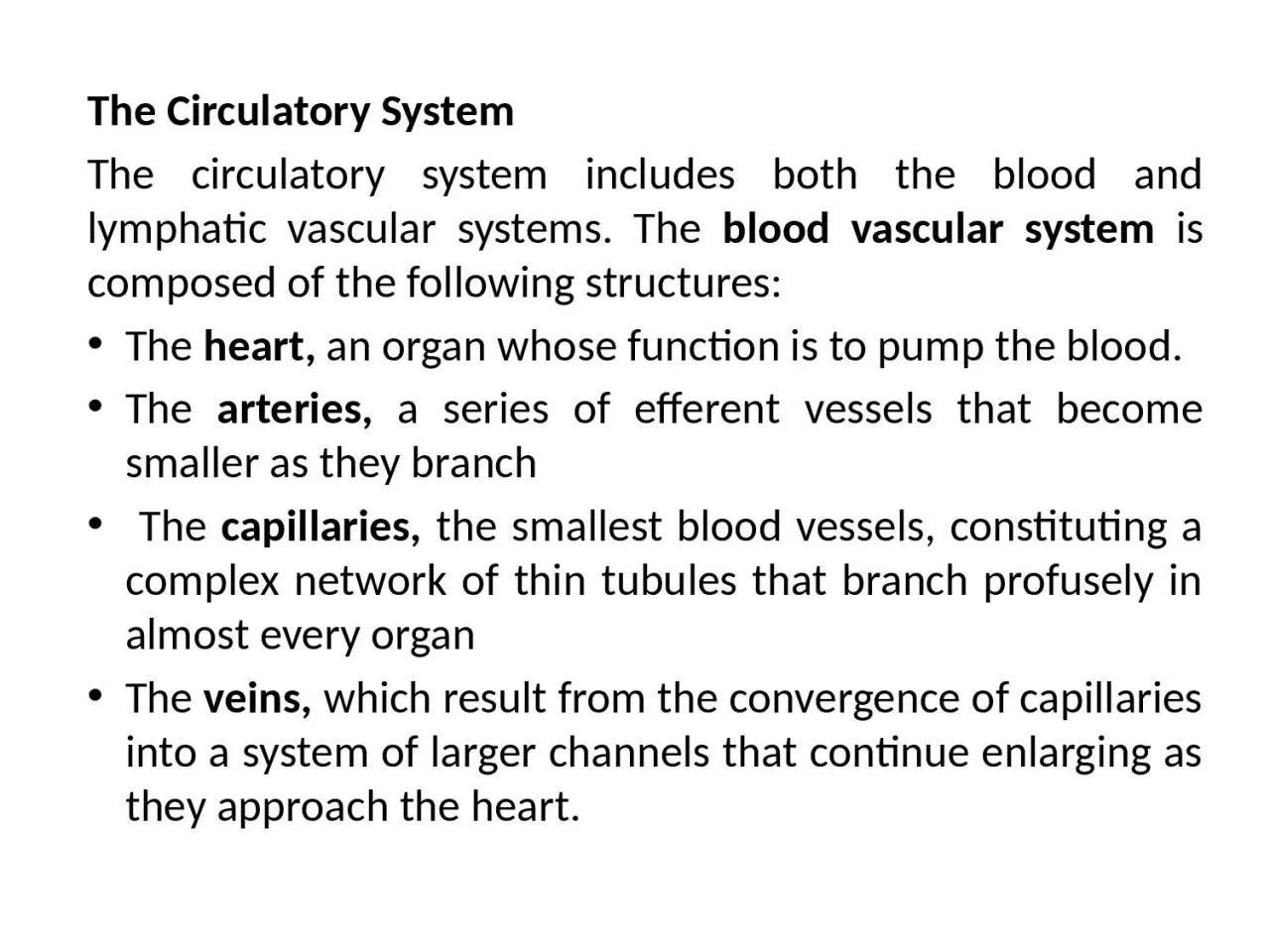

blood vascular system is composed of the following structures The heart an organ whose function is to pump the blood The arteries a series of efferent vessels that become smaller as they ID: 1033382
Download Presentation The PPT/PDF document "The Circulatory System The circulatory s..." is the property of its rightful owner. Permission is granted to download and print the materials on this web site for personal, non-commercial use only, and to display it on your personal computer provided you do not modify the materials and that you retain all copyright notices contained in the materials. By downloading content from our website, you accept the terms of this agreement.
1. The Circulatory SystemThe circulatory system includes both the blood and lymphatic vascular systems. The blood vascular system is composed of the following structures:The heart, an organ whose function is to pump the blood.The arteries, a series of efferent vessels that become smaller as they branch The capillaries, the smallest blood vessels, constituting a complex network of thin tubules that branch profusely in almost every organ The veins, which result from the convergence of capillaries into a system of larger channels that continue enlarging as they approach the heart.
2. The lymphatic vascular system: begins with the lymphatic capillaries, which are closed-ended tubules that merge to form vessels of steadily increasing size; these vessels terminate in the blood vascular system emptying into the large veins near the heart. One of the functions of the lymphatic system is to return the fluid of the tissue spaces to the blood. The internal surface of all components of the blood and lymphatic systems is lined by a single layer of a squamous epithelium, called endothelium
3.
4. HeartThe heart is a muscular organ that contracts rhythmically, pumping the blood through the circulatory system. The right and left ventricles pump blood to the lungs and the rest of the body respectively; right and left atria receive blood from the body and the pulmonary veins respectivelyThe walls of all four heart chambers consist of three major layers or tunics: the internal endocardium; the middle myocardium; and the external epicardium.
5.
6. Smooth muscle: cells or fibers occur in the walls of all vessels larger than capillaries and are arranged helically in layers. In arterioles and small arteries the smooth muscle cells are frequently connected by communicating gap junctions.Connective tissue: Collagen fibers are found throughout the wall in the subendothelial layer, between muscle layers, and in the outer layers. Elastin predominates in large arteries where it forms parallel lamellae regularly distributed between the muscle layers., contributing to the wall's physical properties and affecting permeability and diffusion of substances through the wall.
7. Large Elastic ArteriesLarge elastic arteries help to stabilize the blood flow. The elastic arteries include the aorta and its large branches. Freshly dissected, they have a yellowish color from the elastin in the media. The intima is thicker than the corresponding tunic of a muscular artery. An internal elastic lamina, although present, may not be easily discerned.
8. Muscular ArteriesThe muscular arteries can control blood flow to organs by contracting or relaxing the smooth muscle cells of the tunica media. The intima has a very thin subendothelial layer and the internal elastic lamina, the most external component of the intima, is prominent. The tunica media may contain up to 40 layers of more prominent smooth muscle cells which are intermingled with a variable number of elastic lamellae (depending on the size of the vessel) as well as reticular fibers and proteoglycans. An external elastic lamina, the last component of the media, is present only in the larger muscular arteries. The adventitia consists of connective tissue. Lymphatic capillaries, vasa vasorum, and nerves are also found in the adventitia and these structures may penetrate to the outer part of the media
9. Arterioles Muscular arteries branch repeatedly into smaller and smaller arteries, until reaching a size with only two or three medial layers of muscle. The smallest arteries branch as arterioles, which have one or two smooth muscle layers and indicate the beginning of an organ's microvasculature where exchanges between blood and tissue fluid occur. Arterioles are generally less than 0.5 mm in diameter, with lumens approximately as wide as the wall is thick.
10.
11. Capillaries anastomose freely, forming a rich network or bed that interconnects the arterioles and venules. The arterioles may first branch into smaller vessels with a sparse layer of smooth muscle called metarterioles, which branch further into capillaries.
12. VenulesThe transition from capillaries to venules occurs gradually. The immediate postcapillary venules are similar structurally to capillaries, with pericytes. Postcapillary venules participate in the exchanges between the blood and the tissues and. These venules converge into larger collecting venules which have more contractile cells.
13. VeinsBlood entering veins is under very low pressure and moves toward the heart by contraction of the tunica media and external compressions from surrounding muscles and other organs. Valves project from the tunica intima to prevent back-flow of blood. Most veins are small or medium veins, with diameters less than one centimeter.